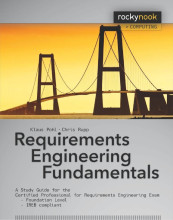Model-Based Requirements Documentation
8 important questions on Model-Based Requirements Documentation
During model-based documentation of requirements there are three types?
- Goals; describe intentions of stakeholders or groups of stakeholders.
- Use cases and Scenarios; document exemplary sequences of system usage. Senarios are grouped together in use cases.
- System Requirements; detailed functions and qualities that the system to be developed shall implement or possess.Also serve as input for subsequent development
Models have three important properties:
- Mapping of reality
- Descriptive model construction (AS IS)
- Prescriptive model construction(TO BE)
- Reduction of reality
- Selection - een onderdeel wordt gemodeleerd
- Compression - het systeem wordt als geheel weergegeven
- Pragmatic property
The documentation of requirements in the form of conceptual models offersthe following advantages:
- Information presented in pictures is quicker to understand and memorize
- Requirements models allow the targeted modeling of one perspective on the requirements
- By defining the modeling language for the particular purpose, an appropriate abstraction of reality can already be specified
- Higher grades + faster learning
- Never study anything twice
- 100% sure, 100% understanding
A Goals model is?
- Goals are a stakeholder’s description of a characteristic property of the system to be developed or the development project
- The positive impact of modeled goals on requirements engineering is very high
- The effort required to explicitly consider goals during requirements engineering is minimal
- Refining a goal is known as goal decomposition
The use case approach is based on two complementary documentation techniques?
- Use case diagrams
- Use case specifications
Typical modeling elements for use case diagrams are
- Actors (people or other systems) in the system context: Actors are outside the system boundary and interact with the system.
- The system boundary.
- Other Use cases (that are defined for the system).
- Extend relation: an interaction sequence that belongs to use case A extends some interaction sequence in use case B, triggered by a defined condition (extension point).
- Include relation: interaction sequence of the first use case includes the interaction sequence of the other use case.
- Relation between actors and use cases.
Within the scope of model-based documentation, requirements for the system to be developed are modeled in three overlapping modeling perspectives:
- Data perspective
- Functional perspective
- Behavioralperspective
Requirements Modeling in the Functional Perspective is?
The question on the page originate from the summary of the following study material:
- A unique study and practice tool
- Never study anything twice again
- Get the grades you hope for
- 100% sure, 100% understanding

Topics that are related to Model-Based Requirements Documentation
-
Model-Based Requirements Documentation - Requirements Modeling in the Data Perspective
-
Model-Based Requirements Documentation - Requirements Modeling in the Functional Perspective - Data Flow Diagrams
-
Model-Based Requirements Documentation - Requirements Modeling in the Functional Perspective - UML Activity Diagrams
-
Model-Based Requirements Documentation - Requirements Modeling in the Behavioral Perspective































